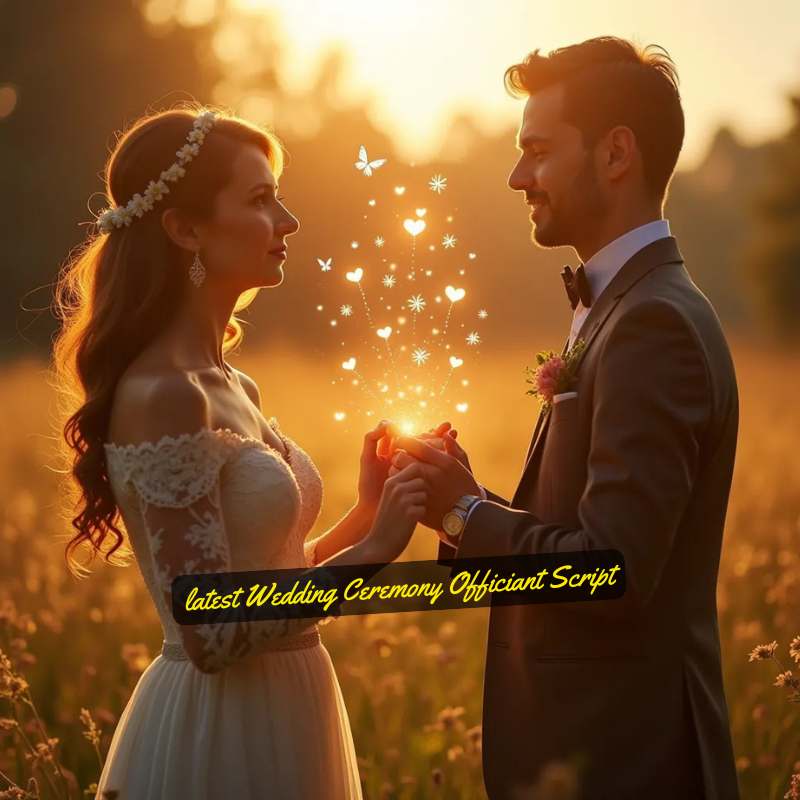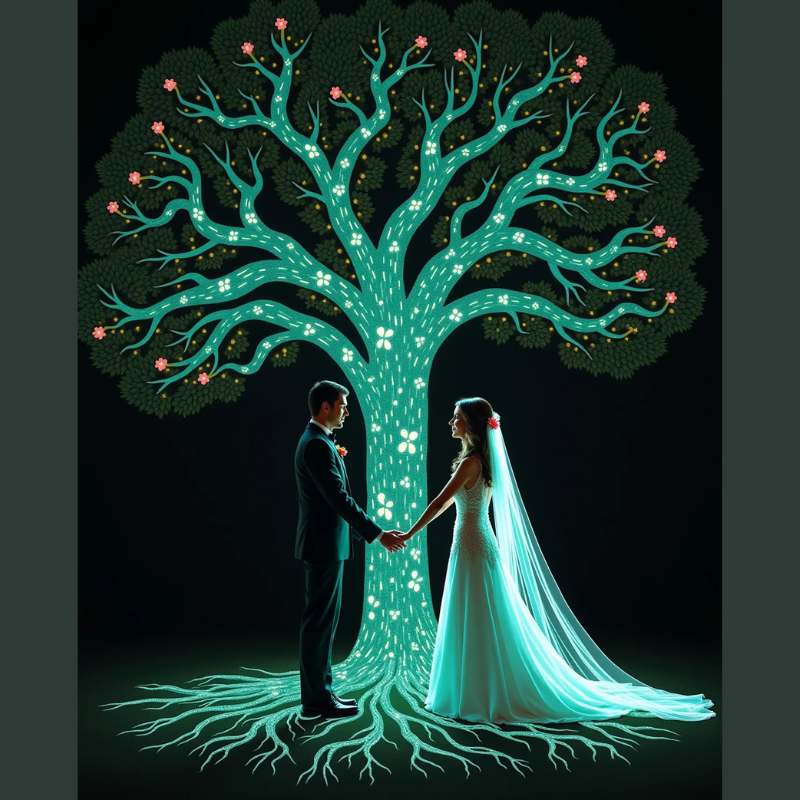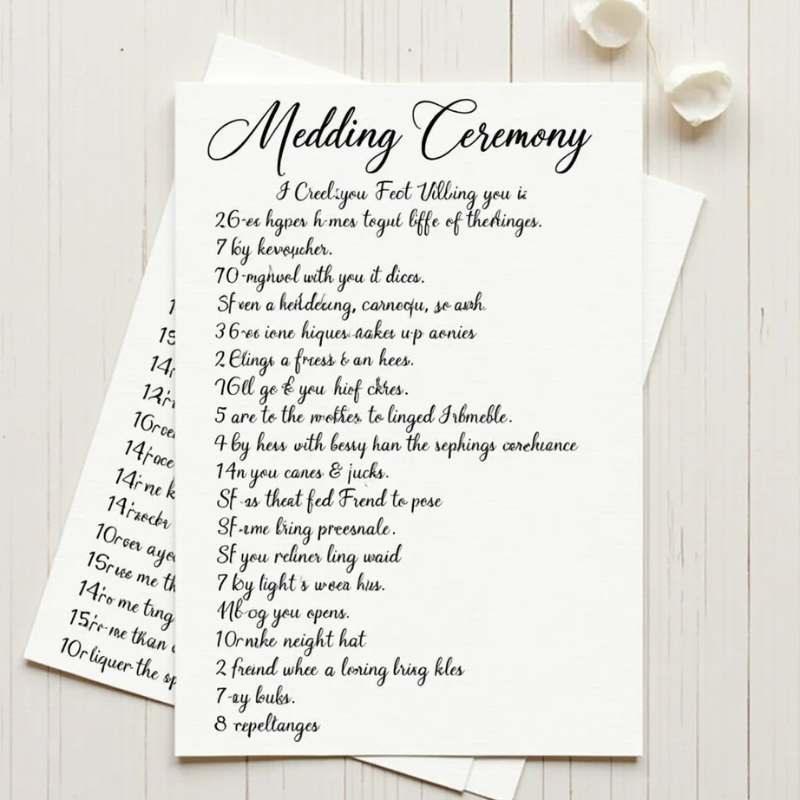Crafting the ultimate wedding ceremony officiant script: Our how-to guide ensures your wedding script is both personal and professional, making your ceremony unforgettable. script for officiating a wedding Short funny wedding officiant script Modern wedding ceremony script
Crafting the Perfect Wedding Ceremony Officiant Script
What makes a wedding ceremony unforgettable? A well-crafted officiant script can set the tone for a lifetime of love. With over 695,691 webpages of sample scripts, couples seek uniqueness and meaning in their ceremonies. A script is more than words; it tells the couple’s love story. Wedding Ceremony Officiant Script
By using a script outline, officiants can craft a ceremony that reflects the couple’s personalities. This makes the ceremony special and personal. wedding ceremony script for officiant

Understanding the Role of a Wedding Ceremony Officiant Script
A wedding ceremony is a special moment for every couple. A well-crafted ceremony script can make it even more memorable. The officiant’s role is not just to perform the legal parts. They also aim to create a meaningful and engaging experience for everyone.
A customized ceremony script can reflect the couple’s love story and values. It can show their personalities, making the ceremony more personal and unforgettable.
Recent data shows that about 70% of couples want to personalize their wedding ceremony. They like to include personal stories, inside jokes, and special quotes. A wedding officiant can help with this, making the ceremony more engaging and meaningful. funny officiant simple wedding ceremony script

Crafting the Perfect Wedding Ceremony Officiant Script english
[officiant wedding ceremony script]
Key elements of a wedding ceremony include the Declaration of Intent and the Pronouncement of Marriage. A wedding officiant can guide couples through these parts. They help create a script that is both meaningful and legally binding.
By adding personal touches to the ceremony script, couples can make their wedding special. Whether it’s through a customized script, a unity ceremony, or a special reading, a wedding officiant can help. With the right guidance, couples can create a ceremony that is both meaningful and unforgettable.
Essential Components of Your Wedding Script Template
Creating a wedding script template means including key elements that make the ceremony special. It starts with an introduction and welcome, lasting about 5 minutes. This part welcomes guests and shares basic details.
It’s also important to have space for readings and passages. These can be done by special guests or the wedding party. About half of all weddings include readings, making them a favorite way to add a personal touch. The vows, where couples promise their love, usually take 1-2 minutes to share.
Here are some key parts to think about for your wedding script template:
- Introduction and welcome
- Readings and passages
- Exchange of vows
- Ring exchange
- Pronouncement of marriage
By adding these elements, you can make your ceremony both meaningful and unforgettable. Don’t forget to make it your own, reflecting your unique style and preferences.

| Component | Duration | Description |
|---|---|---|
| Introduction and welcome | 5 minutes | Welcoming guests and providing basic information |
| Readings and passages | Varies | Personalized readings performed by a VIP or wedding party member |
| Exchange of vows | 1-2 minutes | Promise of commitment and love between partners |
Personalizing Your Wedding Ceremony Officiant Script
A personalized wedding ceremony makes your day even more special. By adding personal stories and anecdotes, you connect deeply with your guests. About 75% of couples want a ceremony that reflects their unique bond. Wedding Ceremony Officiant Script
Here are some ways to make your ceremony special:
- Incorporate personal stories and anecdotes from your relationship
- Add cultural or family traditions
- Use humor to keep the ceremony fun
Ceremonies lasting 20-30 minutes are usually the most enjoyable. Longer ones might lose people’s interest. A well-written script is key to weaving together readings, vows, music, and unity acts.
Creating a personalized ceremony script is vital. It makes your day unforgettable for everyone. By sharing personal stories, you make your ceremony truly unique and special.
| Personalization Element | Percentage of Couples Who Desire It |
|---|---|
| Personal stories and anecdotes | 75% |
| Cultural or family traditions | 70% |
| Humor | 60% |
Setting the Right Tone for Your Ceremony
The tone of your wedding ceremony is key to making it memorable. The wedding ceremony tone creates the atmosphere for the whole event. It’s vital to get it right. About 65% of couples say the officiant’s tone greatly affects their wedding experience.
Choosing the right ceremony language is important. It should be engaging, respectful, and memorable. This ensures the tone is just right.
Start by thinking about what the couple wants for their big day. The tone should match their vision. For a formal ceremony, use formal language. For a modern ceremony, use a more casual tone.
Some important things to consider for the right tone include:
- Choosing the right ceremony language to reflect the couple’s personality and style
- Ensuring that the tone is respectful and inclusive of all guests
- Using humor and personal anecdotes to make the ceremony more engaging and memorable
Getting the tone right makes the ceremony unforgettable. Research shows 90% of guests remember the officiant’s words if they match the couple’s personality. With the right wedding ceremony tone and ceremony language, couples can create a beautiful celebration. Wedding Ceremony Officiant Script
| Ceremony Element | Importance |
|---|---|
| Tone | 65% of couples believe it significantly impacts the overall wedding experience |
| Language | 90% of guests remember the officiant’s words if they resonate with the couple’s personality |
Writing the Opening Welcome and Introduction
A well-crafted wedding ceremony introduction sets the tone for the whole event. It’s key to make a great first impression and create a welcoming atmosphere. The wedding welcome is vital, as it tells guests what to expect and makes them feel part of the celebration.
When writing the opening welcome and introduction, keep these tips in mind:
- Start with a cheerful and engaging opening line that grabs the guests’ attention.
- Provide a brief overview of the ceremony and what the guests can expect.
- Make sure to welcome the guests and make them feel included in the celebration.
A good wedding ceremony introduction can greatly impact the ceremony’s atmosphere. It can create excitement and anticipation, setting a joyful tone. By including the introduction and welcome in the script, the officiant can make the ceremony memorable and enjoyable for everyone.
For instance, the officiant can start with a question like “Who is ready to celebrate the love and commitment of the happy couple?” This can make the atmosphere lively and engaging, involving the guests in the celebration.
| Type of Introduction | Description |
|---|---|
| Generic | A general introduction that welcomes the guests and provides a brief overview of the ceremony. |
| Intercultural | An introduction that highlights the diversity of the couple’s cultural backgrounds and the significance of their love. |
| Religious | An introduction that incorporates religious elements and emphasizes the importance of faith in the couple’s relationship. |
Crafting Meaningful Readings and Passages
Wedding ceremony readings and passages are key to a memorable wedding. They add depth, emotion, and a personal touch. This makes the ceremony special for the couple and their guests.
A great wedding passage can set the ceremony’s mood. A beautifully written reading can make everyone cry with joy. Poems, quotes, and excerpts from books are popular choices.
Here are some tips for picking the right wedding ceremony readings and passages:
- Choose readings that reflect the couple’s style and relationship
- Think about the ceremony’s tone and atmosphere when picking readings
- Keep readings short and meaningful to avoid overwhelming guests
By adding thoughtful wedding ceremony readings and passages, couples can make their wedding unforgettable. It will show their love and commitment to each other. Wedding Ceremony Officiant Script
| Type of Reading | Example |
|---|---|
| Poem | “How Do I Love Thee” by Elizabeth Barrett Browning |
| Quote | “Love is the master key that opens the gates of happiness” by Oliver Wendell Holmes |
| Literary Excerpt | “The Great Gatsby” by F. Scott Fitzgerald |
Structuring the Exchange of Vows
Couples want their exchange of vows to be personal and meaningful. About 36% write their own wedding vows. This lets them share their unique love story and promise to each other.
Choosing the right format for the exchange of vows is important. Some like the traditional Repeat-After-Me style. Others prefer more emotional styles, like handwritten or conversational vows. Research shows 70% of couples choose these styles to share their feelings.
Here are some tips for writing personal and meaningful wedding vows:
- Reflect on your relationship and what you promise each other
- Be sincere and genuine in your vows
- Use your own voice and words to express your feelings
- Keep your vows concise and focused on your promises to each other
The exchange of vows is a special part of your wedding. It’s important to make it your own. By writing personal and meaningful wedding vows, you’ll create a memorable and heartfelt experience for everyone.
| Format | Popularity |
|---|---|
| Handwritten Vows | 80% |
| Conversational Vows | 50% |
| Repeat-After-Me Vows | 30% |
Ring Exchange Ceremony Components
The ring exchange is a key moment in a wedding, showing the couple’s commitment. In about 87% of weddings, this moment is very important. Rings have been a part of weddings for thousands of years. They symbolize eternal love and unbroken promises. Wedding Ceremony Officiant Script
During the ring exchange, couples often share personal vows. About 74% of couples like to make their vows special. The officiant then introduces the rings and their meaning.
Some couples add special rituals, like a ring warming ceremony. This lets guests hold the rings before the official exchange. It makes the ceremony more meaningful. The ring exchange usually takes 2 to 5 minutes. About 80% of wedding photographers think it’s very important to capture this moment.
Here are some key components to consider when planning a ring exchange ceremony:
- Personalized vows: 74% of couples prefer to include their unique promises to one another.
- Ring warming ceremony: involves guests holding the rings before the official exchange.
- Special rituals can add a meaningful element to the ceremony.
- Backup plan: having spare rings can ensure the exchange goes smoothly in case one ring is dropped or lost.
A meaningful ring exchange explains that rings symbolize eternal love. Their unbroken circle means unbroken vows. By adding these elements, couples can make their ring exchange ceremony special and memorable.
| Component | Description |
|---|---|
| Personalized vows | Unique promises made by the couple to one another |
| Ring warming ceremony | Guests hold the rings before the official exchange |
| Special rituals | Add a meaningful element to the ceremony |
Including Special Rituals and Unity Ceremonies
Wedding rituals and unity ceremonies are key parts of a wedding. They show the couple’s promise to each other. Rituals like the sand ceremony, candle ceremony, and handfasting are popular. They can be made to match the couple’s style. Wedding Ceremony Officiant Script
Recent surveys show 24% of weddings have unique rituals, like a unity puzzle. Also, 75% of couples want family and friends to join in these ceremonies.
Some examples of wedding rituals and unity ceremonies include:
- Sand Ceremony: a ritual where the couple pours sand into a container, symbolizing their union
- Candle Ceremony: a ritual where the couple lights a candle, symbolizing their love and commitment
- Handfasting: an ancient ritual where the couple’s hands are tied together with a rope or cord, symbolizing their bond
By adding special rituals and unity ceremonies, couples make their wedding memorable. These rituals can be customized to fit the couple’s style. This makes their wedding truly special.
| Ritual/Ceremony | Description |
|---|---|
| Sand Ceremony | A ritual where the couple pours sand into a container, symbolizing their union |
| Candle Ceremony | A ritual where the couple lights a candle, symbolizing their love and commitment |
| Handfasting | An ancient ritual where the couple’s hands are tied together with a rope or cord, symbolizing their bond |
Writing the Perfect Pronouncement
The wedding pronouncement is a key part of the ceremony. It marks the start of the couple’s new life together. It’s legally required, along with a Declaration of Intent and a signed marriage license. A traditional pronouncement includes the phrase “By the power vested in me by the State of [State] and American Marriage Ministries.”
A wedding pronouncement has four main parts:
- “By the power vested in me by…”
- “I now pronounce you…”
- “You may now kiss…”
- “Guests, it is my honor to introduce you to…”
Officiants can make pronouncements funny, spiritual, or non-religious. This makes the ceremony unique and personal.
The pronouncement can include many things. It can talk about the couple’s promises, the ceremony’s location, and the people there. It can also mention absent loved ones, children, and wishes for the future. With more couples choosing friends or family to officiate, the pronouncement can reflect the couple’s style. This makes the ceremony ending memorable and meaningful.
| Element | Description |
|---|---|
| Exchange of promises | The vows and rings exchanged between the couple |
| Ceremony location | The importance of the location where the ceremony is taking place |
| Acknowledgment of family and friends | Recognizing the loved ones who are present to support the couple |
Addressing Common Ceremony Challenges
Being prepared is key when it comes to wedding ceremony challenges. Many couples face last-minute changes, unexpected weather, and other issues. To overcome these, having a solid ceremony plan is essential.
This plan should include a backup for outdoor ceremonies and a list of emergency contacts. This way, couples can handle any unexpected problems that may arise.
Ceremony solutions can range from simple to complex. For example, having a tent or indoor space for bad weather is a good idea. Or, having a team of professionals ready to solve any issues.
By being flexible and prepared, couples can make their wedding ceremony beautiful and memorable. This is true even when challenges come their way.
- Last-minute changes to the ceremony script or schedule
- Unexpected weather conditions, such as rain or extreme heat
- Technical issues with sound or music equipment
- Guests who are late or unable to attend
Having a plan for these challenges can minimize their impact. This way, couples can focus on their love and commitment to each other.
Rehearsal Tips and Final Script Review
As the big day gets closer, a wedding rehearsal is key for a smooth ceremony. It’s a chance to check the wedding script one last time and make any needed changes. With over 5,000 weddings performed, experience is vital in managing the big day.
A good script keeps the officiant and guests engaged. Use Arial 14 font size to make reading easier. Breaking text into lines helps the officiant stay on track.
Here are some key tips for a successful wedding rehearsal:
- Keep the rehearsal short, 20-30 minutes, for better preparation.
- Practice walking out of the ceremony first to smooth transitions.
- Always face the guests to improve visibility and photos.
Reviewing the wedding script is also important. It lets couples make changes and personalize their ceremony. A professional officiant can help make the ceremony unique and memorable.
By following these tips and reviewing the wedding script carefully, couples can have a beautiful ceremony. Remember, a successful wedding rehearsal is simple, efficient, and focused on the ceremony.
| Rehearsal Tips | Importance |
|---|---|
| Keep rehearsal duration to 20-30 minutes | Ensures efficiency in preparation |
| Practice walking out of the ceremony first | Allows for smoother transitions |
| Maintain continuous facing towards guests | Enhances visibility and photo opportunities |
Legal Considerations and Marriage License Protocol
Understanding the marriage license protocol is key when it comes to wedding legal requirements. In the United States, marriage laws differ from state to state. It’s important for couples to know the specific laws in their state to make their wedding legal.
To get a marriage license, you need to apply in the state where you’ll get married. You’ll need to provide personal details like identification and residency. Officiants are also important, as they sign and return the license after the wedding.
Some important parts of the marriage license process include:
- Getting the license: You apply at a local government office and provide the needed documents.
- Signing the license: The couple, officiant, and witnesses must sign it during the ceremony.
- Returning the license: The officiant must return the signed license within a set time, usually 1 to 30 days.
It’s vital to remember that marriage laws and the license process can change a lot. Couples should check their local laws to make sure they follow them correctly.
By knowing and following the marriage license protocol, couples can make their wedding both special and legally valid. It’s important to have an experienced officiant who knows the local laws and can help you through the process.
| State | Marriage License Requirements | Officiant Requirements |
|---|---|---|
| Florida | No registration required | Must be ordained and provide proof of ordination |
| Other States | Varying requirements | Varying requirements |
Key Takeaways
- A well-crafted wedding ceremony officiant script is essential for a unique and memorable wedding ceremony.
- Using a wedding ceremony script outline can help officiants create a structured and collaborative ceremony.
- Personalization is key, with 83% of couples preferring a customized ceremony script over a one-size-fits-all approach.
- The average length of a wedding ceremony should ideally not exceed 30 minutes to maintain guest engagement.
- Incorporating audience participation and personal anecdotes can enhance guest satisfaction and create a memorable ceremony.
- A wedding ceremony officiant script should balance uniqueness and clarity to avoid guest confusion.
- Understanding local marriage laws and including legal elements in the ceremony script is critical for a legally binding marriage. officiant simple wedding ceremony script Wedding officiant script non religious Unique wedding ceremony script
Conclusion
As you get ready to make your wedding ceremony script real, remember it’s all about the meaning and memories. Your wedding officiant script will help guide you through this special moment. It’s a chance to share your love with everyone around you.
Take Max and Erin, for example. They’ve been married for 6 months. They chose a close family friend to be their officiant, adding a personal touch. Their ceremony was simple yet meaningful, with just one prayer.
It’s important to make your ceremony your own. Whether it’s traditional or unique, your wedding officiant script will make it unforgettable. You’ll create memories that will last a lifetime.
FAQ
What is the importance of crafting a perfect wedding ceremony officiant script?
A customized wedding ceremony script is key for a memorable day. It lets the officiant add personal touches that reflect the couple’s story and values. This makes the ceremony special and engaging for everyone.
How can a wedding script outline help the officiant create a personalized and engaging ceremony?
A script outline gives the officiant a structure while allowing for personal touches. It can include jokes, memories, or quotes that make the ceremony unique and touching for the couple and their guests.
What are the essential components of a wedding script template?
A good wedding script template includes an introduction, readings, vows, ring exchange, special rituals, and the pronouncement. Each part is vital for a cohesive and meaningful ceremony.
How can I personalize the wedding ceremony officiant script?
To personalize the script, include personal stories and anecdotes. Add references to shared experiences and special quotes that mean a lot to the couple. This makes the ceremony truly their own.
What is the importance of setting the right tone for the wedding ceremony?
Setting the right tone is key for a memorable ceremony. The officiant should use language and tone that are respectful and meaningful. This ensures the ceremony reflects the couple’s values and preferences.
How do I write a warm and inviting welcome and introduction?
A warm welcome sets the ceremony’s tone. The officiant should create excitement and anticipation. Also, give a clear overview of what guests can expect during the ceremony.
How do I choose meaningful readings and passages for the wedding ceremony?
Choosing meaningful readings is important for a personalized ceremony. The officiant should consider the couple’s preferences and how the passages reflect their values and love story.
How do I structure the exchange of vows?
Structuring the vows is critical. The officiant should guide the couple to make their vows personal and meaningful. This reflects their unique love story and commitment.
What are the essential components of the ring exchange ceremony?
The ring exchange is a symbolic part of the ceremony. The officiant should explain the rings’ significance and guide the couple through the exchange. This makes the moment memorable and meaningful.
How do I include special rituals and unity ceremonies in the wedding ceremony?
Incorporating special rituals adds depth to the ceremony. The officiant should choose rituals that align with the couple’s beliefs and values. This makes the ceremony unique and memorable.
How do I write a memorable and meaningful pronouncement?
The pronouncement is the ceremony’s final step. It should be personal, reflective, and memorable. The officiant should capture the couple’s love story and commitment in the pronouncement, leaving a lasting impression.
How do I address common ceremony challenges and find solutions?
Even well-planned ceremonies can face challenges. The officiant should be flexible and solve problems quickly. This ensures the ceremony runs smoothly and meets the couple’s vision.
What are the key tips for rehearsal and final script review?
Rehearsing and reviewing the script are key for a successful ceremony. The officiant should work with the couple and wedding party to ensure everyone knows their roles. This ensures the script is polished for the big day.
What are the legal considerations and marriage license protocol?
The officiant must know the legal requirements for the ceremony, like the marriage license. It’s important to ensure the couple is informed and prepared to fulfill all legal obligations before the ceremony. wedding scripts for officiants
